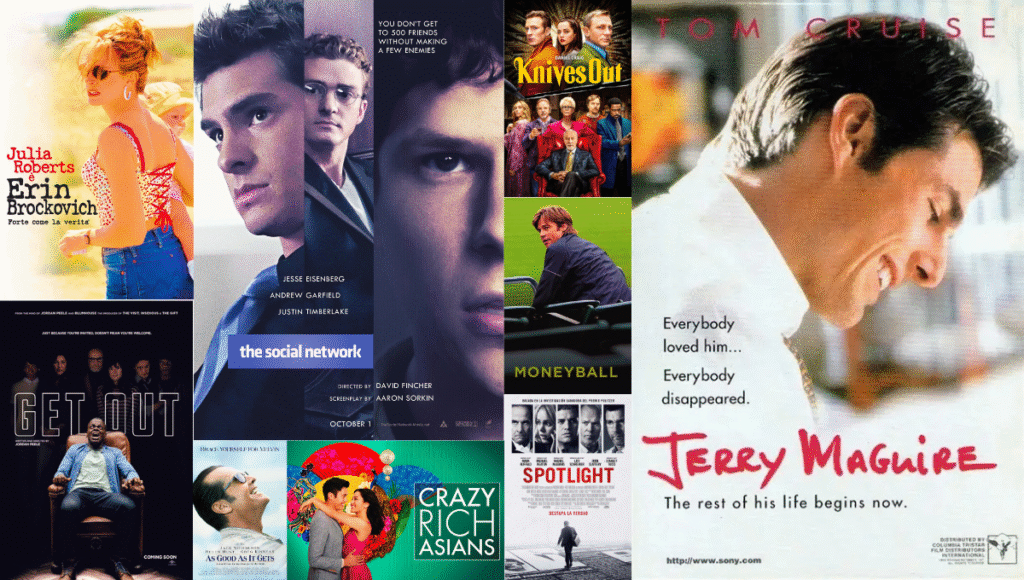Mid-budget movies once ruled theaters with smart storytelling and modest budgets, so why are they vanishing from today’s Hollywood?
Remember when mid-budget movies like Jerry Maguire, The Social Network, or Erin Brockovich dominated theaters without relying on superheroes, sequels, or $200 million budgets?
These films, usually made for $20–50 million, were thoughtful, character-driven stories that felt like true events.
But in 2025, mid-budget movies have almost completely disappeared from the big screen. What happened to this cinematic middle ground, and why does it matter?
The Rise and Fall of the Middle Class… of Movies
In the ’90s and early 2000s, mid-budget movies were Hollywood’s sweet spot. Studios could bet on interesting scripts, rising stars, or respected directors without risking a studio’s entire bottom line.
These films might not have grossed $1 billion worldwide, but they were profitable and often award magnets.
Fast forward to today, and studios are chasing two extremes:
- Blockbusters: $150M+ tentpoles like Avengers or Fast & Furious that dominate global box offices.
- Micro-budget or streaming originals: $2–10 million horror films or indie dramas made for digital platforms.
That healthy, creative space in the middle? It’s shrinking fast.
Economics Over Art
Why the shift away from mid-budget movies? In a word: money.
Movies are more expensive than ever to make and market.
A $40 million film today might need another $40 million for advertising. That math makes studios nervous unless the project screams guaranteed success.
A smart legal thriller or a poignant drama might break even or even turn a small profit, but it doesn’t offer Marvel-level returns or the low risk of an indie hit. Studios now want scalability: franchises, merchandising, spinoffs. Mid-budget movies rarely offer those options.
Streaming Changed Everything – Kind Of
You might be thinking: “Aren’t those mid-budget movies just on Netflix now?” Yes, but it’s complicated.
Streaming platforms have become a new home for adult dramas, romantic comedies, and character-driven thrillers. Films like Marriage Story, The Irishman, and The Lost Daughter found critical acclaim online.
But here’s the downside:
- Most don’t get wide theatrical releases.
- They often drop with little promotion.
- They rarely become cultural moments.
Take Air, starring Ben Affleck and Matt Damon. It was a textbook mid-budget movie, but it barely made a splash on Amazon. In another era, it would’ve been an Oscar season contender.
The Theater Is for Spectacle Now
Post-pandemic, going to the theater has become an event. If people are leaving their homes, they want epic: superhero blockbusters, horror thrillers, or action spectacles.
Mid-budget movies? Audiences figure they’ll catch those at home.
Unless it’s directed by someone like Christopher Nolan or stars Leonardo DiCaprio, most $30–50 million dramas or thrillers aren’t getting theatrical releases at all. Studios reserve those slots for guaranteed box office hitters.
But Audiences Still Crave These Stories
Ironically, there’s still a huge appetite for mid-budget movies, it’s just migrated to prestige TV.
Shows like Succession, The Bear, and Severance are mid-budget films in episodic form. They offer layered characters, strong writing, and compelling visuals, the very things audiences loved on the big screen.
Even Barbie and Oppenheimer proved that with the right marketing, original storytelling can succeed massively. While those weren’t mid-budget, they carried the spirit of thoughtful cinema that connects deeply with viewers.
Who’s Still Fighting for the Middle?
Thankfully, a few champions of mid-budget movies remain:
- Directors like Jordan Peele, Greta Gerwig, and Damien Chazelle continue to make $30–50 million films that thrive both critically and commercially.
- Studios like A24, Neon, and Focus Features keep supporting theatrical releases in this range, even if limited.
- Ben Affleck and Matt Damon launched Artists Equity to finance exactly the kind of films studios have stopped backing, classic mid-budget movies with fairer pay models.
Why Mid-Budget Movies Matter
This isn’t about bashing big-budget films. Many of them are fantastic.
But the loss of mid-budget movies means less diversity in storytelling.
These films used to be breeding grounds for:
- Fresh directorial voices
- Actor breakouts
- Real-world stories and timely issues
They gave us cultural moments without explosions or multiverses. Without them, cinema becomes narrower.
What the Future Might Look Like
There is hope. As superhero fatigue sets in and streaming platforms face profitability concerns, mid-budget movies might stage a comeback.
Studios could return to smaller theatrical bets. Streaming services might scale back bloated content slates in favor of higher-quality originals. Film festivals and limited releases could once again become launchpads for these stories.
What can audiences do?
- Buy tickets to that $25 million drama.
- Support that $35 million courtroom thriller.
- Watch and recommend films that tell rich stories without CGI armies.
Because if mid-budget movies disappear for good, we’ll all be stuck in a cinematic landscape of prequels, reboots, and endless franchises.
And honestly, don’t we deserve more than that?



